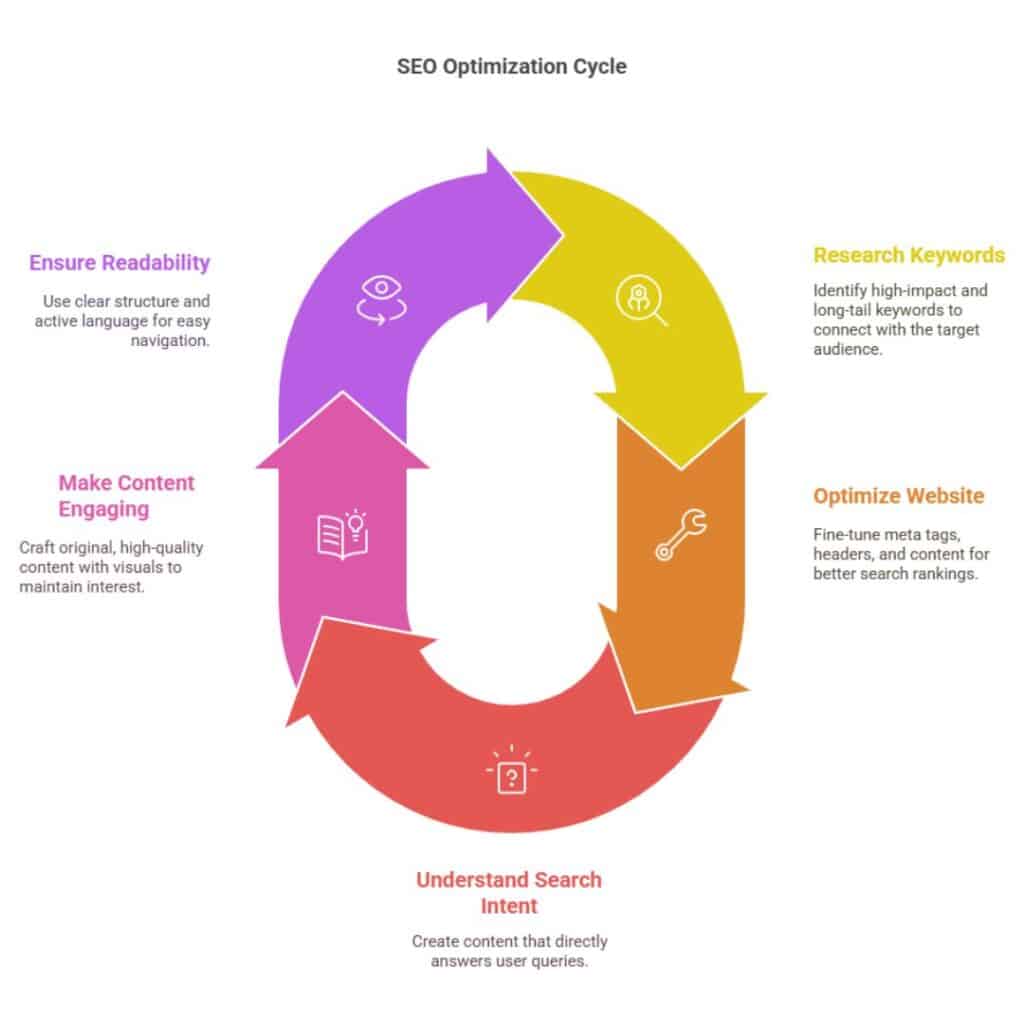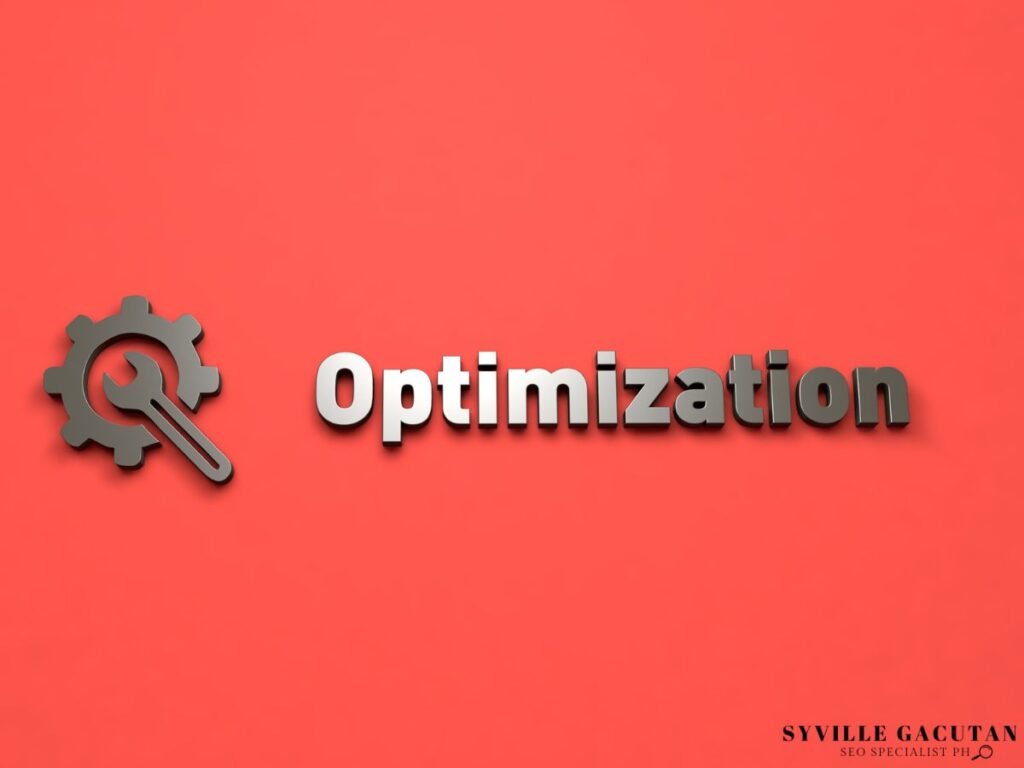
Beginner’s Guide to SEO Content Creation Strategies
To kick off your SEO content creation efforts, focus on boosting your website’s visibility with a few key strategies. Start with on-page optimization by using relevant meta tags and organizing your content in a clear, logical structure. Dive into keyword research to discover the phrases your audience is actually using, and take advantage of long-tail keywords to target niche areas. Understanding the different types of search intent—whether users are looking for information or ready to make a purchase—helps you create content that meets their needs. Write original, high-quality content that fills gaps and keeps users engaged with compelling visuals and storytelling. Remember to fine-tune your meta tags for optimal performance, keeping within character limits to maximize their impact. As you dig deeper into these SEO Content Creation Strategies for Beginners, you’ll find even more ways to refine and master your SEO content approach.
Key Takeaways
- Research the right keywords: Find high-impact and long-tail keywords that will connect with your target audience and make your content more discoverable.
- Optimize your website’s key elements: Fine-tune meta tags, headers, and content to not only improve your search rankings but also create a better experience for your users.
- Understand search intent: Create content that directly answers what people are looking for, whether it’s information, navigation, transactions, or research for making decisions.
- Make content engaging: Focus on crafting original, high-quality content that tells a story and uses visuals to keep your audience interested and help them understand your message better.
- Keep it easy to read: Ensure your content is easy to follow with a clear structure, active language, helpful headings, and bullet points so visitors can quickly find what they need.

Understanding SEO Basics
To really get the hang of digital marketing, it’s crucial to understand the basics of SEO. SEO, or Search Engine Optimization, is all about improving your website’s visibility and helping it rank higher on search engines like Google. At its core, it’s about making sure both your site’s structure and content are optimized not just for search engines but also for the people who visit your site. Mastering these fundamentals is key to attracting more visitors and standing out online.
One pivotal aspect of SEO is on-page optimization, which involves refining individual web pages to boost their search engine rankings. This process includes optimizing meta tags, headers, and ensuring that content is relevant and high-quality.
Establishing a clear content hierarchy is crucial, as it guides both search engines and users through the website intuitively, improving the user experience. This hierarchy is achieved through the strategic use of headings and subheadings, ensuring that the most critical information is easily accessible.
User experience is another key component of SEO basics. A seamless, engaging experience not only keeps visitors on the page longer but also reduces bounce rates, signaling to search engines that the content is valuable. This entails ensuring fast page load speeds, mobile responsiveness, and intuitive navigation.
Furthermore, staying informed about algorithm updates is vital. Search engines frequently refine their algorithms to deliver more relevant search results. Awareness and adaptation to these updates ensure that websites maintain or improve their search rankings.
Importance of Keyword Research

Keyword research is a fundamental component of successful SEO strategies, as it provides insights into the terms and phrases potential customers use when searching for products or services. By understanding these search habits, businesses can tailor their content to meet user demands, thereby improving visibility and engagement.
The process begins with utilizing keyword tools, which offer a wealth of data on search volume and trends, helping to pinpoint high-impact keywords that align with business objectives. Incorporating long tail keywords into content is particularly effective, as these phrases often reflect specific search intents and face less competition compared to broader terms.
This tactic not only aids in capturing niche audiences but also enhances the likelihood of conversion due to their targeted nature. Additionally, conducting a thorough competitor analysis allows businesses to identify which keywords are driving traffic to similar sites, thereby uncovering potential opportunities or threats in the market.
A crucial aspect of keyword research is identifying content gaps, which are areas where customer needs remain unmet by existing content. By addressing these gaps, businesses can create unique, valuable content that positions them as an authoritative source in their industry.
This proactive approach not only attracts more visitors but also encourages longer engagement and repeat visits. Ultimately, effective keyword research lays the foundation for a robust SEO strategy, guiding content creation efforts and ensuring alignment with audience expectations.
Analyzing Search Intent
Understanding the motivations behind a user’s search is the next step after identifying the right keywords, as it provides critical insights into how to effectively meet their needs. Analyzing search intent involves deciphering why a user performs a particular search and what they hope to achieve.
Successful SEO content aligns with user behavior and intent categories to ensure that the content delivered matches user expectations and requirements.
Search intent is generally divided into four main categories:
- Informational Intent: Users seek knowledge and answers to questions. Crafting content that provides valuable insights and answers is key to satisfying this intent.
- Navigational Intent: Users aim to locate a specific website or page. Ensuring that your site is easily navigable and appears in relevant navigational searches is crucial.
- Transactional Intent: Users are ready to purchase or complete a specific action. Content should facilitate a smooth transaction, emphasizing clear calls to action and straightforward navigation.
- Commercial Investigation: Users compare products or services before making a purchase decision. Content that highlights product benefits, comparisons, and reviews serves this intent well.
Understanding query types is essential for content alignment. For example, short-tail keywords often correlate with informational intent, while long-tail keywords may indicate transactional intent.
Aligning content with these queries ensures that user needs are met efficiently. By comprehensively analyzing search intent, SEO strategies can be fine-tuned to cater to user behavior, enhancing user experience and increasing the likelihood of achieving business objectives.
An insightful approach to search intent not only optimizes content but also builds trust and credibility with the audience.
Crafting Quality Content

Creating high-quality content is the cornerstone of effective SEO strategies. In a digital landscape saturated with information, content originality is paramount. It not only captures the attention of search engines but also resonates with your audience, setting you apart from competitors. Original content showcases unique insights and expertise, fostering trust and authority within your niche.
Engaging visuals further enhance your content’s appeal, as they break the monotony of text and can significantly boost user interaction. By incorporating images, infographics, or videos, you provide diverse ways for your audience to engage with your message, potentially increasing the time they spend on your site—a critical factor for SEO success.
Storytelling techniques are another powerful tool in crafting quality content. Narratives that evoke emotions or solve problems can create a memorable experience, encouraging readers to engage more deeply. By weaving stories into your content, you make complex topics more relatable and enjoyable, thereby enhancing comprehension and retention.
Audience targeting is essential when crafting content. Understanding the preferences and needs of your target audience allows you to tailor your message accordingly. This not only improves user experience but also increases the likelihood of your content being shared, further enhancing its reach and effectiveness.
Optimizing Meta Tags

An essential aspect of enhancing your SEO performance lies in optimizing meta tags, as these small snippets of code provide search engines with crucial information about your webpages.
Meta tags, although not directly visible to users, play a significant role in influencing search engine rankings and click-through rates. To effectively utilize these tags, it is imperative to understand the various meta tag formats and their specific functions.
- Title Tag Optimization: The title tag is often the first impression users receive from your page in search results. Ensure it accurately reflects the content, incorporates primary keywords, and adheres to character limit guidelines of 50-60 characters to prevent truncation.
- Description Tag Strategies: Crafting a compelling meta description can significantly impact click-through rates. This tag should succinctly summarize the page content, include relevant keywords, and remain within the 150-160 character limit guidelines to maintain visibility.
- Schema Markup Benefits: Implementing schema markup can enhance the way search engines interpret your content, offering rich snippets that improve visibility and potentially increase traffic.
This structured data format provides additional context, such as product details or reviews, directly within search results.
- Character Limit Guidelines: Adhering to recommended character limits is crucial to ensure that your meta tags are fully visible in search results.
Overstepping these limits can lead to truncated text, diminishing the clarity and effectiveness of your tags.
Enhancing Readability

Improving readability is crucial for engaging users and ensuring they can easily digest the information presented on your website. A well-structured and readable website encourages visitors to spend more time exploring, which can positively impact search engine rankings. To enhance readability, consider focusing on several key elements, including sentence structure, visual hierarchy, and the use of concise paragraphs.
Firstly, sentence structure plays a fundamental role in readability. Aim for clarity and simplicity by using active voice, which makes sentences more direct and easier to understand. Avoid overly complex sentences that could confuse readers. Instead, break down information into manageable parts.
Secondly, establish a strong visual hierarchy on your pages. This involves organizing content in a way that guides the reader’s eye through the material. Use headings and subheadings to divide content into sections, making it easier for users to find relevant information quickly. Visual elements like bullet points can also help in summarizing complex data, allowing readers to grasp the main points without wading through dense text.
Moreover, concise paragraphs are essential in maintaining reader interest. Shorter paragraphs prevent information overload and make text appear less intimidating. Each paragraph should focus on a single idea, providing clarity and coherence to the overall piece.
Ultimately, enhancing readability is about making it effortless for users to engage with your content. By prioritizing clear sentence structure, effective visual hierarchy, and concise paragraphs, you not only improve user experience but also boost your SEO performance, ensuring your content reaches a wider audience.
Final Thoughts
Mastering SEO content creation strategies is crucial for building a strong online presence and ensuring your website ranks well in search engine results. By focusing on essential elements like keyword research, understanding search intent, optimizing meta tags, and creating engaging, high-quality content, you can effectively reach and engage your target audience. Additionally, improving readability and enhancing user experience are key factors that contribute to your content’s overall success. With consistent effort and a user-centered approach, you can refine your SEO strategy and achieve long-term visibility and growth.
Need expert help mastering SEO content creation for your website? Connect with Syville Gacutan, an experienced SEO Specialist in the Philippines. Syville can help you create high-quality, optimized content that drives traffic and boosts your search rankings. Contact today and start transforming your website’s performance!